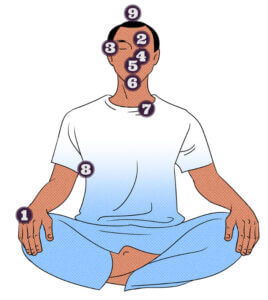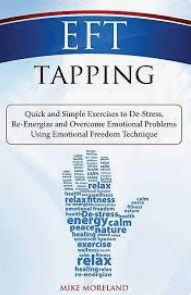
What is EFT Tapping?
Benefits and How To Use EFT Tapping
Disclaimer
Although there are increasing and surmounting clinical and anecdotal evidence indicating that many people benefit from the use of sensory based stress management techniques such as “Tapping,” these techniques are still considered experimental in nature. The information presented here is intended to inspire and educate visitors, to promote awareness of the benefits, and to support the learning of some self-calming techniques.
EFT tapping, also known as Emotional Freedom Technique tapping, is a therapeutic method designed to help relieve anxiety, stress, and other emotional issues. This alternative therapy combines aspects of acupressure and psychology to provide a mindful approach to releasing negative emotions and physical symptoms.
The benefits of tapping are vast, as it offers a non-invasive and self-empowering method for managing emotions and physical symptoms. While there are various ways to perform EFT tapping, the basic practice involves tapping with your fingertips on specific acupoints while focusing on the issue at hand and repeating positive affirmations. This step-by-step approach assists in the release of negative emotions and encourages calmness and clarity.
What Is The Emotional Freedom Technique?
Tapping commonly known as EFT, or ABC, TFT, TTT, etc. call it what you will, is more researched clinically and is well established to be considered an evidence based modality. It is an alternative therapy for anxiety, post-traumatic stress disorder (PTSD), and other conditions for reducing psychological distress through self-stimulation of acupoints on the face and upper body while focusing on sensations in the body, or a distressing thought or feeling. With its roots in traditional Chinese medicine, tapping aims to restore balance to your disrupted energy, helping you achieve emotional and physical well-being.
Its Origin
EFT tapping was developed in the 1990s by Gary Craig, a Stanford-trained engineer and performance coach, who adapted it from Roger Callahan’s Thought Field Therapy (TFT). While TFT required a more complex approach, Craig simplified the process, making it accessible to a wider audience. Since its inception, EFT tapping has gained popularity and is now used by many practitioners around the world.
The Idea Behind EFT Tapping Therapy
The concept of tapping lies in the belief that our body has energy channels called meridians. These meridians can become disrupted due to unresolved emotional issues or negative experiences, leading to emotional and physical discomfort. The effect of EFT helps by stimulating specific meridian points while focusing on the issue at hand.
To practice tapping, you tap gently on different meridian points of the body (listed below) while reciting specific phrases that address the area you want/need relief. This process sends signals to the stress centers of the mid-brain, effectively reducing the stress or negative emotion you feel, and ultimately restoring balance to your disrupted energy.
Benefits of EFT Tapping
Stress and Anxiety Reduction
Tapping can be a great tool for alleviating negative emotions. As you tap, focus on a reframing of the issue causing you stress and observe how your body and mind respond to the stimulation.
Improved Mental Health
Research suggests that those that use eft tapping could experience relief from emotional distress, making it easier to deal with tough situations and maintain a positive outlook. By consistently practicing EFT tapping, you could experience improvement in your mental well-being over time.
Physical Pain Management
A tapping practice is believed to help relieve chronic pain for some individuals. By tapping on specific meridian points and focusing on the area of pain, you may be able to release tension and find relief. Remember that it is essential to consult with a healthcare professional if you experience severe or persistent pain.
Enhanced Performance
Tapping can contribute to enhanced performance in various aspects of your life, such as work, sports, and personal goals. By focusing on your current barriers and tapping on the acupoints, you can potentially reduce psychological distress and increase your focus, motivation, and confidence. With regular practice, you may find that EFT tapping helps you overcome mental blocks and achieve your desired outcomes more effectively.
What Are Tapping Points?
The Tapping Sequence
To get started with the emotional freedom technique, follow this simple sequence:

- Identify the issue: Choose a specific problem or emotion that you want to work on, such as anxiety or fear. Keep this issue in mind as your focal point during the tapping process.
- Rate the intensity: Measure your emotional distress on a scale of 0 to 10, with 10 being the most intense. This will help you track your progress throughout the tapping process.
- Create a setup statement: Formulate a sentence that acknowledges the issue you’re facing, along with a phrase of self-acceptance. For example: “Even though I feel anxious, I deeply and completely accept myself.” While traditional practioners like to state the issue before a reframing statement, I prefer to just state the affirmation.
- Begin tapping: Start by tapping the side of your hand (known as the karate chop point) while repeating your setup statement three times. Then, tap each of the following points about seven times, while focusing on your issue and repeating a reminder phrase:
- Eyebrow (EB)
- Side of the eye (SE)
- Under the eye (UE)
- Under the nose (UN)
- Chin (CH)
- Collarbone (CB)
- Under the arm (UA)
- Top of the head (TH)
- Reassess your intensity: After completing the tapping sequence, rate your emotional distress again on the 0-10 scale. Continue the process during your tapping session until you notice a significant reduction in your intensity.
Keep in mind that tapping points may differ depending on who to talk to about it. I’ve seen less points and more points over the years. Find which sequence feels most comfortable for you. Here is an excellent video from the GA Tech ECE that demonstrates tapping.
Tips for Effective Tapping
- Remain focused: Stay connected to your emotions throughout the entire tapping process while avoiding distractions.
- Be persistent: Tapping can require several rounds before you experience relief. Don’t give up if your intensity level doesn’t drop immediately.
- Adjust your language: If you’re not seeing progress, consider modifying your affirmation or reminder phrases to better pinpoint your emotional issue.
- Experiment with timing: Some people find that tapping in the morning, before bed, or during breaks throughout the day can enhance the effectiveness of tapping.
As you practice EFT tapping, remember to be patient and gentle with yourself. It may take some time to see results, but with persistence and focus, you can experience its benefits in your emotional well-being.
Cautions and Considerations for EFT Therapy
Before diving into EFT tapping, it’s essential to be aware of some cautions and considerations. Keep in mind that tapping may not work for everyone and should not replace professional medical advice.
Firstly, if you have a medical or mental health condition, consult with a healthcare professional before trying EFT tapping. While it may help with anxiety or stress, it is not a cure-all and should be used alongside other treatments and therapies.
Additionally, some people might experience emotional distress during the tapping process, especially if focusing on traumatic memories or deep-rooted issues. If you feel overwhelmed at any point, stop the practice and reach out to a professional therapist or counselor.
EFT tapping involves tapping on specific acupressure points on your body, so it’s crucial to be gentle and not cause pain or injury. Do not tap too aggressively or use excessive force. If you feel pain or discomfort, adjust your pressure and technique accordingly.
Lastly, keep in mind that results and progress with tapping may vary for each individual. Some people might experience immediate relief, while others may require consistent practice to notice improvement. Be patient and don’t get discouraged if the technique doesn’t yield instant results.
By being cautious and keeping these considerations in mind, you can safely explore tapping as a potential tool to support your emotional well-being.
Future Research and Potential
EFT tapping has shown promise in providing relief for a variety of mental and emotional issues, but there is still much to learn about this technique. In the future, researchers may focus on understanding the specific mechanisms behind tapping and how to maximize its effectiveness for various conditions.
One biggest area where EFT tapping has gained attention is its potential for lowering stress and anxiety. Studies suggest that this technique may help quiet the amygdala, which is involved in the stress response. More research on the neurological effects of tapping could illuminate this connection further, giving practitioners a deeper understanding of how to better address anxiety and stress-related disorders.
Additionally, the possible benefits of EFT tapping extend beyond mental health. Some evidence suggests that it can also be helpful in improving physical pain, sleep patterns, and even diminishing cravings. Future research may explore these connections more in-depth, potentially revealing new applications for tapping and expanding its role in comprehensive healthcare plans.
Finally, as the demand for alternative and integrative therapies grows, more robust studies comparing EFT tapping to other forms of treatment, such as cognitive behavioral therapy (CBT) or medication, will be essential. By conducting long-term controlled studies, researchers can better understand the efficacy and potential of EFT tapping as a standalone or complementary treatment.
At the end of the day, EFT tapping holds considerable potential for addressing various mental, emotional, and even physical issues. As more research is conducted, we may gain a deeper understanding of this technique, uncovering new possibilities and expanding the reach of EFT tapping in the realm of health and well-being.
Remember to always consult with a healthcare professional before beginning any alternative therapy, including EFT tapping.






